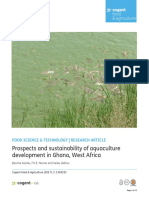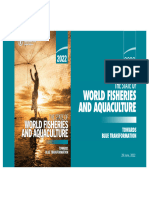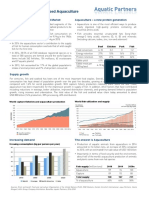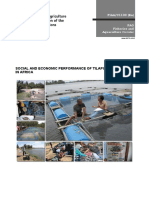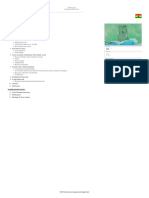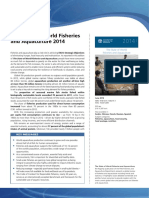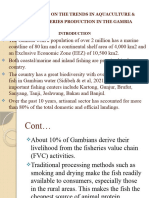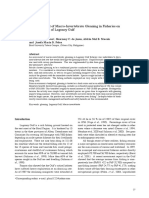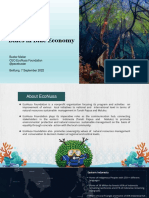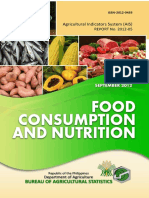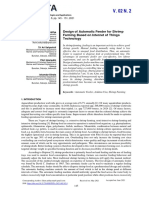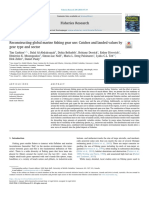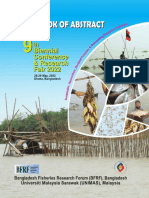Introduction
Fish are a vital global food source. In 2022, world fisheries and aquaculture production hit a record 223.2
million tonnes 1 , reflecting steadily rising demand. Aquatic foods now supply about 15% of global animal
protein and 6% of total protein 2 . Global per capita fish consumption has grown from 9.1 kg in 1961 to
20.7 kg in 2022 3 , indicating fish’s growing role in nutrition. Tilapia – especially Nile tilapia (Oreochromis
niloticus) – is among the most widely farmed fish worldwide. Global tilapia production was forecast to rise
~2–4% in 2022 4 , with strong demand in Africa driving exports from major producers like China and
Indonesia 5 .
Africa’s per-capita consumption, however, remains below global averages and may even decline in coming
years as population outpaces fish production 6 . In contrast, Ghana’s fish consumption is already very
high. Recent data show Ghana’s per capita fish intake reached 20–25 kg/year, far above the ~9–10 kg typical
of sub-Saharan Africa 7 . Fish provide roughly 60% of Ghanaians’ animal protein 8 . Tilapia is a leading
farmed species in Ghana, with the local market preferring fresh tilapia even though much supply is
imported 9 . Lake Volta alone supports tens of thousands of tons of tilapia production annually, chiefly for
domestic consumption 9 .
In Ghana’s Northern Region (Tamale area) fish demand is likewise rising. Tamale’s growing population relies
on a variety of fish – smoked, frozen and fresh – for nutrition 10 . Daily market influxes of multiple species
(including tilapia, catfish, redfish, mudfish, etc.) testify to this demand 10 . However, fish spoils quickly from
microbial growth 11 , making hygiene and cooking practices critical. This review examines fish (especially
tilapia) consumption worldwide and in Ghana, common microbial hazards in grilled tilapia, the effects of
cooking/handling on safety, Ghanaian food-safety regulations (including in Tamale), and recommendations
for safer practices.
Fish and Tilapia Consumption Worldwide and in
Ghana
Globally, fish has become an increasingly important protein source 3 . Aquatic foods now constitute about
one-fifth of the animal protein supply for 3.2 billion people 2 . Tilapia is one of the fastest-growing
aquaculture products. World production of tilapia continues to expand, meeting strong global demand 4 .
The FAO notes robust African demand has kept tilapia exports high, even as production in some traditional
suppliers (China, Latin America) faces challenges 5 . Recent reports predict global tilapia production will
continue its growth trajectory into the mid-2020s 4 .
In Ghana, fish is a dietary staple. Ghana’s annual per-capita fish consumption peaked around 20–25 kg 7 ,
vastly exceeding the sub-Saharan African average. Domestic aquaculture and capture fisheries cannot fully
meet this demand. For example, Tropo Farms (a major Lake Volta tilapia producer) notes that Ghana’s
“domestic tilapia market is about 80% imports” despite a ban on tilapia imports 9 . Ghanaian consumers
still prefer fresh local tilapia and consider imported frozen tilapia apparently cheaper 12 . Ghana’s National
1
�Aquaculture Sector Overview confirms average per-capita fish intake above 25 kg 7 . Fish provides roughly
60% of animal protein in Ghana’s diet 8 , underscoring its nutrition-security role.
In Tamale Metropolis (Northern Region), the importance of fish – especially cheaper species – is clear.
Studies report that Tamale residents depend increasingly on a mix of smoked, frozen, and fresh fish 10 .
Daily markets supply a variety of species, from tilapia and catfish to anchovies and sardinella. One survey
found smoked and frozen fish are widely consumed; among smoked fish tilapia is common, and among
frozen fish tilapia is preferred despite its higher cost 13 . The rise in fish demand has expanded Tamale’s
fish markets and fish retail trade 10 . These trends mean that ensuring the microbial safety of fish (like
grilled tilapia sold in restaurants and chop bars) is crucial for public health.
Common Microbial Contaminants in Grilled Tilapia
Tilapia – fresh or cooked – can harbor various microbes. Typical contaminants in freshwater fish include
Gram-negative bacteria like Salmonella, Escherichia coli (fecal coliforms), Plesiomonas, Aeromonas, Vibrio (in
brackish waters) and Campylobacter, as well as Gram-positives like Staphylococcus aureus and Bacillus
species. Many of these can cause foodborne illness if not eliminated by heat or prevented by hygiene.
Studies of tilapia from African markets confirm these hazards. For example, an Ethiopian survey found
Bacillus spp., Salmonella spp., E. coli, and Staphylococcus spp. dominated the microflora of raw and
semicooked tilapia fillets 14 . Salmonella was isolated from 25–30% of samples 14 , and some raw tilapia
had coliform and staphylococcal counts above safe limits. The study also noted generally poor handling –
vendors lacked training, sanitation and education – likely contributing to contamination 15 . Similarly, a
Ghanaian study of grilled tilapia sold in Tamale found significant counts of total coliforms and Salmonella
spp. in the finished product 16 . In that Tamale survey, total coliform counts averaged log 4.28 CFU/g and
Salmonella counts averaged log 3.11 CFU/g 16 . E. coli was not detected, but heterotrophic plate counts
were also elevated (mean ≈8.97×10^2 CFU/g) 16 . The researchers attributed contamination to unsanitary
equipment, handlers’ poor hygiene, and environmental exposures (flies, dust) 17 .
More broadly, studies in Ghana and Nigeria list similar pathogens. A scoping review of foodborne hazards in
Ghana notes that bacteria found on local foods include Salmonella spp., E. coli, Staphylococcus spp., Vibrio
(including V. cholerae) and Listeria monocytogenes 18 . These are consistent with pathogens known to occur
in freshwater fish. Importantly, many of these are eliminated by thorough cooking, but their presence in
raw or inadequately cooked tilapia underscores the need for safe preparation.
Impact of Cooking and Handling on Microbial
Safety
Cooking and handling practices critically affect fish safety. Proper cooking (high heat) kills most pathogens
present in raw fish. For instance, Salmonella spp. – one of the most heat-sensitive foodborne bacteria – will
survive cold storage but are destroyed by thorough cooking or smoking 19 . In practice, cooking methods
like grilling, baking or frying sharply reduce microbial loads on fish. One review noted that cooking methods
(boiling, frying, grilling) caused “sharp reduction in the microbial load (TVC)” of fish 20 . In the FDA’s
Ghanaian code of practice, potentially hazardous foods “requiring cooking shall be cooked to … at least
2
�65°C or above for 15 seconds” to ensure safety 21 . The code also mandates use of a food thermometer to
verify internal temperatures 22 . Altogether, thermal processing can render grilled tilapia microbiologically
safe—provided the fish is fully cooked.
However, post-cooking handling and hygiene can re-contaminate food. After grilling, ready-to-eat tilapia
may be exposed to environmental microbes or touched with dirty utensils or hands. Cross-contamination
from surfaces or tools that handled raw fish is a known hazard. For example, even if a tilapia steak is grilled
thoroughly, placing it on an unclean plate or slicing it with a contaminated knife can transfer pathogens
onto it. Studies emphasize that hygiene at local markets and eating places is often poor. In Ghana, surveys
have found that “improper handling of food at local markets [and] hygiene practices of food vendors” are
major sources of food contamination 23 . Lack of handwashing facilities, use of bare hands on food, and
inadequate cleaning of equipment are common. In the Ethiopian study of tilapia, nearly all vendors lacked
formal training, and key sanitation amenities (clean water, soap) were absent 15 . In Tamale, the grilled-fish
study similarly pointed to vendors’ personal hygiene and handling practices as likely contamination sources
17 .
In summary, proper cooking of tilapia will kill most microbial contaminants 19 21 , but any lapse in
temperature control or in post-cook hygiene can result in unsafe food. Safe handling thus requires both
adequate thermal processing and strict hygienic practices (handwashing, clean utensils, protected storage).
Food Safety Standards and Regulatory Framework
in Ghana and Tamale
Ghana has a formal food safety regulatory framework enforced by agencies like the Food and Drugs
Authority (FDA) and local assemblies. Nationally, the FDA oversees restaurant and street-food hygiene. Its
Code of Hygienic Practice for Food Service Establishments (2013) sets detailed requirements. For example, it
mandates that frozen or refrigerated foods be thawed only under controlled conditions (in refrigeration
≤5°C or under potable running water) 22 . It requires all “potentially hazardous” foods to reach at least
65°C internally when cooked 21 . Vendors must use thermometers to monitor cooking and holding
temperatures 22 . The code also specifies clean water for utensil washing and forbids reuse of tasting
utensils 22 . Equipment and food-contact surfaces must meet Ghana Standards Authority guidelines (e.g.
sinks for manual dishwashing) and be cleaned frequently. In practice, the FDA conducts inspections:
compliant eateries are granted “Food Hygiene Permits,” and facilities demonstrating high standards can
earn a two-year permit exempting them from annual review 24 . Street vendors are likewise inspected and
issued specialized permits in coordination with local government 24 . In effect, the FDA’s licensing system
aims to ensure that restaurants and chop bars follow good hygienic practices (GHP) in food storage,
handling and service 24 22 .
At the policy level, Ghana’s Ministry of Health and partner agencies have developed a National Food Safety
Policy (2022) to coordinate these efforts. The policy emphasizes strengthening regulation and public
awareness across the food chain (from farm/sea to table), though formal enforcement is challenging. In
Ghana overall, legislative tools like the Public Health Act and FDA Act empower inspectors to close
unsanitary premises, although these are unevenly applied in practice.
3
�Locally, the Tamale Metropolitan Assembly’s Environmental Health Unit plays a key role in ensuring food
safety on the ground. Tamale requires all food handlers (e.g. restaurant and street vendors) to obtain a
Food Handlers’ Certificate. Vendors must undergo a medical examination at a sub-metro health office;
only those deemed medically fit receive a certificate (usually issued within two weeks) 25 . The assembly
also inspects hotels, restaurants, and street-food outlets, checking facilities for standards of sanitation, pest
control, waste disposal and staff hygiene 26 . Unsatisfactory premises can be ordered to cease operations
until corrections are made. In short, Tamale’s local regulations complement national law by certifying
vendors and monitoring premises for cleanliness.
In summary, Ghana combines national guidelines (FDA codes, Ghana Standards) with local enforcement
(food-handlers’ certificates, inspections by assemblies) to promote safe food. Any eatery selling grilled
tilapia in Tamale is expected (by law) to have a valid hygiene permit, use FDA-approved procedures (proper
cooking, clean facilities) and have medically certified staff 24 25 . Unfortunately, resource constraints mean
that enforcement is spotty; thus, continuing education and inspections are often recommended (see below).
Recommendations for Improving Food Safety
Practices
The literature suggests several strategies to reduce microbial hazards in grilled tilapia and other street
foods. A recurring theme is training and certification of vendors. In Ghana and Ethiopia alike, researchers
have called for mandatory hygiene training for fish sellers and for more rigorous vendor certification 15
17 . For example, Ampofo-Yeboah et al. (2014) explicitly recommend ensuring “inspection and certification of
fish vendors by [regulatory] bodies” so that consumers get a truly safe meal 17 . Similarly, the Hawassa study
advises offering fish handlers education in good hygienic practices and requiring official certification at
each step of the fish value chain 15 . Training programs (possibly mandatory) would emphasize
handwashing, use of gloves or utensils when handling cooked fish, and proper cleaning of grills and
surfaces to prevent cross-contamination.
Another key recommendation is stricter enforcement of standards. The Ghanaian review by Cudjoe et al.
notes that intentional enforcement of regulations is necessary to curb foodborne illness 27 . In practice,
this means local health authorities must conduct regular inspections of eateries and street vendors, and
impose penalties (fines, license revocation) on violators. Tamale’s assembly could expand its inspections and
ensure only vendors with valid health certificates operate. Coordinated campaigns (perhaps by the FDA and
local health services) to sweep open-air markets and chop bars for compliance could help raise standards.
Monitoring should cover both hygiene (water supply, waste disposal, pest control) and cooking practices
(use of thermometers, no bare-hand contact with ready-to-eat fish).
Improving infrastructure and resources is also important. Studies have pointed out that many vendors
lack access to clean water and washbasins 15 23 . Government or NGO programs could supply basic
handwashing stations and instruct on their use. Building or upgrading market kitchens with proper drains,
covered waste bins and screens can reduce environmental contamination. Ensuring restaurants have
functional refrigeration/freezers and that fish are transported in clean, cooled vehicles would decrease
initial bacterial loads.
4
�Finally, public awareness and consumer education can drive improvements. If consumers demand better
hygiene (e.g. choose vendors who practice safe handling), market forces will push vendors to improve.
Health authorities might run campaigns (posters, radio) reminding citizens that fish should be fully cooked
(no pink meat) and that they should avoid vendors who handle money and food without sanitizing.
In sum, a multi-pronged approach – vendor training, regulatory enforcement, improved facilities, and
consumer awareness – is recommended. As several studies conclude, “rigorous monitoring and evaluation,
coupled with surveillance and education,” along with consistent enforcement of existing laws, are needed to
eliminate foodborne pathogens from the local diet 27 17 .
Conclusion
Fish – and particularly tilapia – is a cornerstone of diets worldwide and in Ghana. Ghana’s high fish
consumption (≈25 kg per capita) highlights its nutritional importance 28 9 . However, tilapia sold in
markets and restaurants often harbors microbial contaminants like Salmonella, E. coli, Staphylococcus,
Bacillus, etc. 16 14 . Thorough cooking greatly reduces these hazards 19 21 , but poor handling or
hygiene can reintroduce pathogens afterwards. Ghana has codified standards – from national FDA codes
(safe cooking temperatures, proper thawing, equipment hygiene) to Tamale’s local health regulations (food-
handler certificates, inspections) – that, if fully implemented, would greatly improve safety 21 25 .
Practically, researchers recommend strengthening these measures through vendor training, more frequent
inspections, and better enforcement 17 15 27 . By combining effective cooking practices with vigilant
hygiene oversight, the risk of foodborne illness from grilled tilapia in Tamale (and Ghana at large) can be
substantially lowered, safeguarding both public health and consumer confidence.
References
Admasu, F., Mikru, A., Workagegn, K. B., & Adane, M. (2023). Microbial profile of fresh and semicooked Nile
tilapia (Oreochromis niloticus) and hygienic practice of fish handlers in Hawassa, Ethiopia. International
Journal of Microbiology, 2023, Article ID 5866719. https://doi.org/10.1155/2023/5866719
Alhassan, E. H. (2012). Smoked and frozen fish consumption and marketing channels in the Tamale Metropolis of
Ghana. Ghana Journal of Development Studies, 9(1), 21–28.
Ampofo-Yeboah, A., Quarcoo, G., Annan, J. E., Abobi, S. M., Alhassan, E. H., Atindaana, S. A., Abarike, E. D., &
Akongyuure, D. N. (2014, September). Microbial analysis of grilled Tilapia fish and their processing practices
in the Tamale Central Sub-Metro of Tamale Metropolis, Ghana. In Proceedings of the UDS Annual
Interdisciplinary Conference. University for Development Studies, Tamale.
Cudjoe, D. C., Balali, G. I., Okareh, O. T., Osafo, R., & Taufiq, M. (2022). Food safety in Sub-Sahara Africa, an
insight into Ghana and Nigeria. Environmental Health Insights, 16, 11786302221142484. https://doi.org/
10.1177/11786302221142484
Food and Drugs Authority (Ghana). (2013). Code of Hygienic Practice for Food Service Establishments (FDA/
FSMD/CP-FSE/2013/03). Ghana FDA.
5
�Food and Drugs Authority (Ghana). (2025). Food Service Establishments Guidelines and Forms. https://
fdaghana.gov.gh/food-service-establishments-guidelines/
Ghana Statistical Service. (2023). Ghana Census of Agriculture: Thematic Brief – Capture Fisheries. Government
of Ghana.
Tamale Metropolitan Assembly. (2023). Environmental Health Service. Tamale Metro Assembly. https://
tamalemetro.gov.gh/environmental-health-service/
Wright, J. (2023, July 24). Ghana’s Lake Volta tilapia farming leader eyes a new growth curve. Responsible
Seafood Advocate. https://www.globalseafood.org/advocate/ghanas-lake-volta-tilapia-leader-eyes-a-new-
growth-curve/
Food and Agriculture Organization of the United Nations. (2024, July 7). FAO report: Global fisheries and
aquaculture production reaches a new record high [Press release]. https://www.fao.org/newsroom/detail/
fao-report-global-fisheries-and-aquaculture-production-reaches-a-new-record-high/en
6
� 1 2 3 6 FAO Report: Global fisheries and aquaculture production reaches a new record high
https://www.fao.org/newsroom/detail/fao-report-global-fisheries-and-aquaculture-production-reaches-a-new-record-high/en
4 5 Species Analysis Tilapia | Globefish | FAO Food and Agriculture Organization of the United Nation
https://www.fao.org/in-action/globefish/species-analysis/tilapia/en
7 8 28 statsghana.gov.gh
https://statsghana.gov.gh/gssmain/fileUpload/Agriculture%20&%20Environment/Thematic%20report_Capture%20Fisheries.pdf
9 12 Ghana’s Lake Volta tilapia farming leader eyes a new growth curve - Responsible Seafood Advocate
https://www.globalseafood.org/advocate/ghanas-lake-volta-tilapia-leader-eyes-a-new-growth-curve/
10 11 13 19 ajol.info
https://www.ajol.info/index.php/gjds/article/view/89911/79364
14 15 (PDF) Microbial Profile of Fresh and Semicooked Nile Tilapia (Oreochromis niloticus) and Hygienic Practice of Fish Handle
in Hawassa, Ethiopia
https://www.researchgate.net/publication/
375641808_Microbial_Profile_of_Fresh_and_Semicooked_Nile_Tilapia_Oreochromis_niloticus_and_Hygienic_Practice_of_Fish_Handlers_in_Hawassa_Ethiop
16 (PDF) Microbial analysis of grilled Tilapia fish and their processing practices in the Tamale Central
17
Sub-Metro of Tamale Metropolis, Ghana.
https://www.researchgate.net/publication/
280775309_Microbial_analysis_of_grilled_Tilapia_fish_and_their_processing_practices_in_the_Tamale_Central_Sub-
Metro_of_Tamale_Metropolis_Ghana
18 23 27 Food Safety in Sub-Sahara Africa, An insight into Ghana and Nigeria - PubMed
https://pubmed.ncbi.nlm.nih.gov/36530486/
20 Changes in fish during cooking methods (frying and grilling): A review.
https://www.alliedacademies.org/articles/changes-in-fish-during-cooking-methods-frying-and-grilling-a-review-11432.html
21 22 fdaghana.gov.gh
https://fdaghana.gov.gh/code-of-practice-for-food-service-establishments/
24 Food Service Establishments Guidelines and Forms – Food And Drugs Authority
https://fdaghana.gov.gh/food-service-establishments-guidelines/
25 26 ENVIRONMENTAL HEALTH SERVICE – Tamale Metro Assembly
https://tamalemetro.gov.gh/environmental-health-service/

